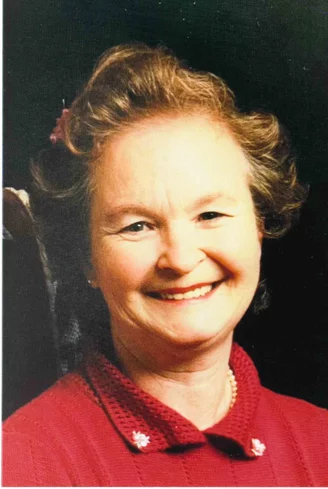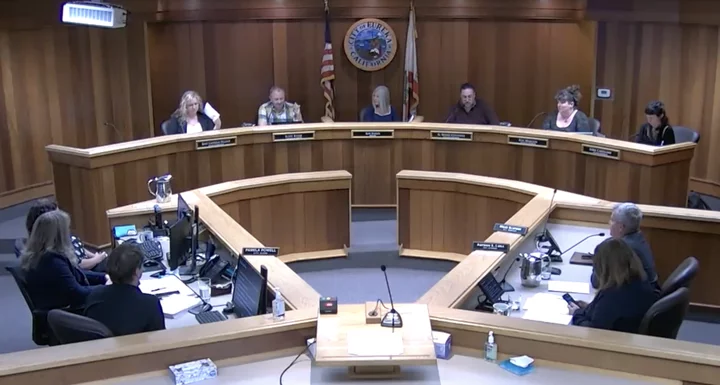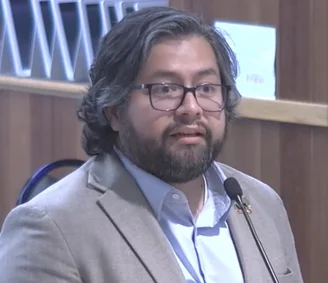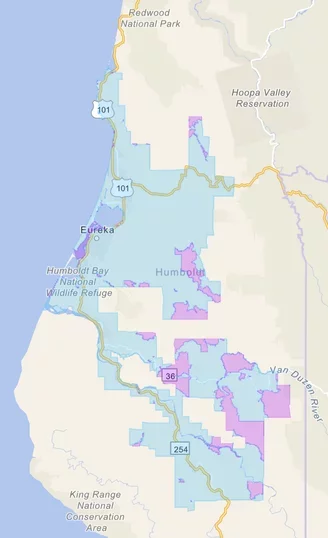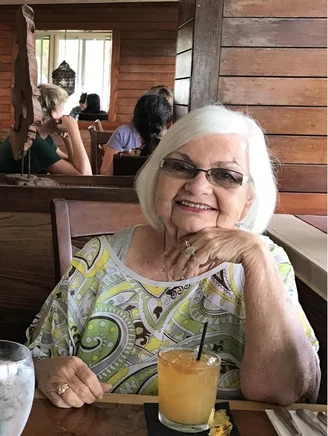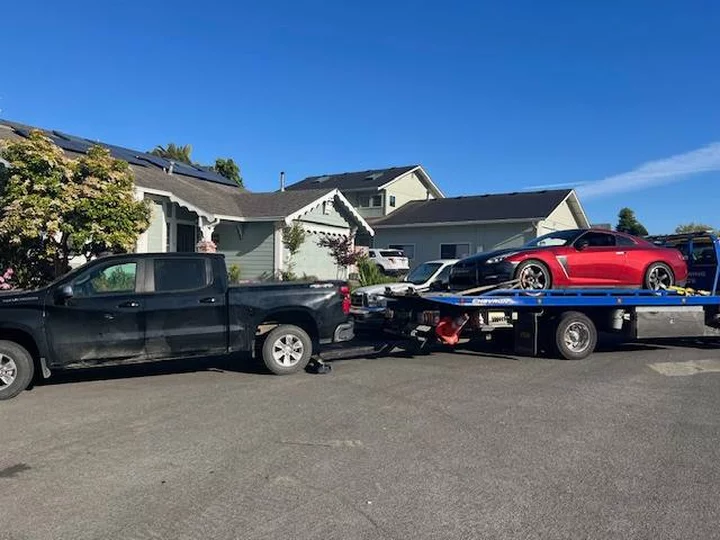OBITUARY: Clarice (Elaine) Vogt, 1925-2024
LoCO Staff / Thursday, June 20, 2024 @ 6:56 a.m. / Obits
On June 1, 2024 Elaine Vogt passed peacefully in her home In McKinleyville, surrounded by family and loved ones.
She was born September 20, 1935 to William (Heartford) Pearl and Ada Pearl near Fresno. Her greatest passion of her life was her family. She married Earl Lee Vogt on the 2nd of September 1950. She had a busy life raising their five children — Mickey, Randy, Janice, Carol and Lee — in Westhaven. Elaine excitingly took up cake decorating so she could make both of her daughters’ wedding cakes. She then became the cake baker of the family. Fishing was an enjoyable pastime for her. She loved volunteering at Hospice and at the Clearlake Senior Center. As Elaine got older her favorite pastimes were reading, working crossword puzzles which kept her mind sharp. She also enjoyed crocheting. She loved to set in her favorite chair and watch the hummingbirds feed and play in the water fountain. Her warm easy smile and infectious laugh will be missed by many.
Elaine was preceded in death by her husband Earl, her oldest son Mickey and youngest son Lee. She was also preceded by two great-grandchildren, Trinten and Austin and great-great-granddaughter Makala.
Elaine is survived by son Randy Vogt and wife Lori; daughter Carol Grimes; daughter Janice Velez and husband Henry; grandchildren Heather Leroy, Colby Vogt, Kathryn Winkelman, Jamie Cooper, Jason Price, Joshua Seddon, Nathan Grimes, Lorisha Scott, Earl Vogt. She was also survived by 22 great grandchildren and five great-great grandchildren.
The family asks in lieu of flowers please donate to
Hospice of Humboldt
3327 Timber Fall Court
Eureka CA 95501
###
The obituary above was submitted on behalf of Clarice Vogt’s loved ones. The Lost Coast Outpost runs obituaries of Humboldt County residents at no charge. See guidelines here.
BOOKED
Today: 11 felonies, 16 misdemeanors, 0 infractions
JUDGED
Humboldt County Superior Court Calendar: Today
CHP REPORTS
3190-4811 Sr3 (RD office): Trfc Collision-1141 Enrt
Sherwood Rd / First Gate Rd (HM office): Trfc Collision-Unkn Inj
100 Mm162 W Men 1.00 (HM office): Trfc Collision-No Inj
ELSEWHERE
County of Humboldt Meetings: MMAC (McKinleyville Municipal Advisory Committee) Joint Meeting with MCSD (McKinlevyille Community Services District) Meeting Agenda - Hybrid Meeting
County of Humboldt Meetings: MMAC (McKinleyville Municipal Advisory Committee) Special Meeting Agenda - Hybrid Meeting
RHBB: Humboldt Has Offshore Wind Potential, Lacks Supply Chain and Workforce Says Consultant
RHBB: Pedestrian Injured After Being Struck by Vehicle in Eureka Thursday Evening
Eureka Council Rebels Against City Attorney’s Summary of the ‘Housing for All’ Initiative, Special Meeting Called Monday to Resolve the Question
Isabella Vanderheiden / Wednesday, June 19, 2024 @ 4:43 p.m. / Local Government
Screenshot of Tuesday’s Eureka Council meeting.
###
At the next municipal election on Nov. 5, Eureka voters will be asked whether or not they want to approve the “Housing for All and Downtown Vitality” initiative, a controversial ballot measure that seeks to stop housing development on city-owned downtown parking lots. How exactly that question will be phrased is still up in the air.
At this week’s regular meeting, the Eureka City Council reviewed the proposed text of the ballot question, which is limited to 75 words, and tried to come up with language that would more accurately convey the intent of the initiative while maintaining neutrality.
Eureka City Attorney Autumn Luna informed the council that Brad Johnson, an attorney representing the proponents of the ballot measure, known as the Citizens for a Better Eureka, had asked the city to change the wording of the ballot question after the council’s agenda was published. (The original wording can be found here, under Section 2.) In the spirit of compromise, Luna said staff granted the request and crafted the following question:
Shall the measure amending Eureka’s General Plan, creating an overlay designation for downtown City lots that limits those lots, with exceptions, to parking and high-density housing, and creating an overlay for the former Jacobs Middle School site, allowing housing, public, quasi-public, and commercial uses, with at least 40% of non-public use area dedicated to high-density housing, subject to review for consistency with state law, by the California Department of Housing and Community Development, be adopted?
Councilmember Leslie Castellano noted that she is “very familiar” with the “Housing for All” initiative, but said she found the ballot question “a little confusing.”
“For instance, it slightly misconstrues the nature of the ballot initiative in terms of limiting the lots with exceptions to parking and high-density housing,” she said. “I mean, it mandates parking if high-density housing is built, which is different than limiting it with exceptions to parking and high-density housing. I just feel like that’s actually an important distinction.”
Luna emphasized how difficult it is to incorporate every aspect of a 19-page ballot initiative into a 75-word question, noting that the question is meant to capture the “spirit of the initiative.”
“We’ve done lots of workshopping internally, and we’ve also taken comment externally from the proponents’ attorney,” she said. “It is such a long initiative, it is very complicated to incorporate all of the different pieces, and that can never be done in 75 words. … If you were to ask 10 different people about what the question should be, you would get 1,000 different answers.”
Castellano expressed concern that the proposed question was “neutral to the point of misinforming the public,” reiterating that the question doesn’t address the requirement for parking if high-density housing is built.
“I hear you, but I think that it really would matter whether you were asking a proponent of the initiative or an opponent of the initiative what the point of the initiative is,” Luna said. “And so therein lies the complexity for us as a city to put a ballot question in front of the voters that doesn’t insert our feeling about it. … We’ve really tried to do the best we can with 75 words, and keeping in mind that neutrality is really important here.”
Councilmember Kati Moulton echoed Castellano’s concerns, adding that the question should clearly state the parking requirement, which is the “crux” of the initiative.
“It doesn’t say [what] makes this kind of a big deal to development,” Moulton said. “That point, I think, is one, why people like it, and two, why people don’t like it. People want that same number of parking spaces to be downtown no matter what gets built there, or people don’t want development that’s required to have expensive parking garages underneath it. I think that’s the crux when it comes to the downtown lots.”
Moulton proposed an amendment to the ballot question but said it would require the “California Department of Housing and Community Development” to be abbreviated. Luna advised against the proposal.
Humboldt County Registrar of Voters Juan Pablo Cervantes, who was in the audience, urged the city council to avoid “whip[ping] something up on the fly” due to the threat of litigation. “I would caution developing the ballot label without your city attorney kind of leading that front,” he added.
Councilmember Scott Bauer praised staff for crafting a “perfectly balanced” question that allows voters to make their own determination. “This is the least biased way to put what is being proposed on the ballot,” he said. “I think it’s well done. Whether we feel a certain way or not about it, it is what it is and it’s going to require people to review what they think the truth is.”
Councilmember Renee Contreras-DeLoach agreed with Bauer and Cervantes, adding that the council should rely on Luna’s expertise.
After a bit of additional discussion, the council voted 4-1, with Bauer dissenting, to revisit the subject during a special meeting on Monday, June 24. Bauer cannot attend the meeting due to a scheduling conflict.
###
What else happened at Tuesday’s meeting?
- The city council also unanimously approved the city’s budget for the 2024-25 fiscal year, which begins on July 1.
- The city council unanimously approved amendments to the city’s Ranked-Choice Voting Ordinance. For the first time in the city’s history, Eureka voters will rank council and mayoral candidates in order of preference (first, second, third, etc.) on their ballots in a system known as ranked-choice voting. The amendments approved at Tuesday’s meeting clarified areas of the city’s ordinance that were “silent” or lacked proper description. During the council’s discussion, Luna assured the council that they could make additional amendments to the ordinance in the future to address issues that may come up during the General Election in November.
- The city council also received a report from Eureka Police Chief Brian Stephens on staffing challenges at the department. Currently, EPD has 48 allocated police officer positions, including 19 patrol officers, four patrol sergeants, four detectives, three CSET (Community Safety Engagement Team) officers, one school resource officer, one drug task force agent and administrative staff. Six soon-to-be officers are in the police academy and five others are going through background checks with the city. Chief Stephens said EPD is trying to pull in new recruits but it is an ongoing challenge because many applicants do not rise to the department’s standards. “I am not just willing to lower the standards of our department and for our community just to fill seats in a car,” he said.
California Public Utilities Commission Expected to Reject AT&T’s Proposal to Discontinue Landline Services at This Week’s Meeting
Isabella Vanderheiden / Wednesday, June 19, 2024 @ 8 a.m. / Infrastructure
###
At its monthly meeting on Thursday, the California Public Utilities Commission (CPUC) is expected to issue a decision on AT&T’s proposal to disconnect landline services for thousands – likely hundreds of thousands – of California customers.
At the beginning of this year, AT&T California applied to remove its status as a Carrier of Last Resort (COLR), which requires the telecommunications giant to provide analog telephone service, or “plain old telephone service,” to residential and business customers. If the application is approved, AT&T will no longer be required to provide landline services in certain areas of Humboldt County, including much of Arcata, Eureka, Fortuna, McKinleyville, Rio Dell, Trinidad and smaller communities along Highway 101 and State Route 299.
AT&T argues that the “outdated” COLR obligation has forced it to “wastefully operate and maintain two duplicative networks: one, an antiquated, narrowband network with an ever-dwindling base of subscribers, and the other, a forward-looking, fiber and wireless broadband network,” as stated in the executive summary of the application.
Elected officials, including state Sen. Mike McGuire, and concerned customers have spoken out against the “dangerous” proposal, fearing it could leave vulnerable residents without reliable phone service.
Last month, the CPUC issued a statement indicating it would reject the proposal due to AT&T’s “fail[ure] to demonstrate the availability of replacement providers [that would be] willing and able to serve as COLR.”
“As the designated COLR, AT&T plays a pivotal role in providing reliable telephone service to communities across the state,” the May 10 statement argues. “Despite AT&T’s contention that providers of voice alternatives to landline service – such as VoIP [Voice over Internet Protocol] or mobile wireless services – can fill the gap, the CPUC found AT&T did not meet the requirements for COLR withdrawal.”
The CPUC received over 5,000 virtually submitted public comments in response to the proposal, many of which “highlighted the unreliability of voice alternatives such as mobile wireless or VoIP,” according to the CPUC.
“With the proposal to dismiss AT&T’s withdrawal request, the CPUC reaffirms its commitment to safeguarding access to essential services and maintaining regulatory oversight of the telecommunications industry,” the statement continues. “Importantly, COLR rules are technology-neutral and do not distinguish between voice services offered (such as Plain Old Telephone Service (POTS), commonly known as landline service, or VoIP), and do not prevent AT&T from retiring copper facilities or from investing in fiber or other facilities/technologies to improve its network.”
AT&T will have a chance to defend its position at the CPUC’s meeting on Thursday. A copy of the proposed resolution can be found here.
A California Senior Lost $700K to Scammers. Now She’s Asking the State to Slow Bank Transfers
Ryan Sabalow / Wednesday, June 19, 2024 @ 7:12 a.m. / Sacramento
Alice Lin’s husband died, and she found herself alone and caring for a disabled son. Then two years ago, the 81-year-old Alhambra woman said she started getting texts from a stranger on a messaging app.
Over the course of a series of friendly chats, he convinced her to wire $720,000 — her entire life savings — to a cryptocurrency app.So she did – in seven separate in-person transactions at her local bank over three weeks. Her life savings disappeared, along with the man who scammed her. For a time, she said she contemplated suicide. But then she got angry – at her bank.
“Despite many red, red flags, my bank failed to consider that I might be a victim of elder fraud,” Lin told the California Assembly’s Banking and Finance Committee this week. “And they did not even contact my daughter, who is the joint account holder on the account.”
In the months since, Lin started working with Consumer Attorneys of California to sponsor Senate Bill 278, a measure aimed at preventing elder fraud scams like the one that drained Lin’s investment accounts.
The bill, by Napa Democratic Sen. Bill Dodd, would require that financial institutions delay transactions of more than $5,000 by at least three days if they “reasonably” suspect an elderly person is a victim of fraud. Banks would be required to train their employees to spot red flags, such as an unusually large and sudden transaction. Banks would also have to take steps to inform an elderly customer’s designated “emergency financial contact” or joint account holder – someone like Lin’s daughter – of a suspected fraudulent transaction.
“Elder financial abuse is everywhere,” Dodd told the banking committee. “Losses exceed $23 billion annually. Once a senior falls prey to financial fraud, they may never recover.”Dodd’s bill passed the Senate this spring with support from every prominent senior advocacy group in California, including the AARP. The measure originally faced intense opposition from the state’s banking and business lobbies, though they’ve since softened their stance after the bill was recently amended.
The financial institutions cite worries that they’d be forced into defacto conservatorships that would give them too much control over an elderly customer’s finances. The restrictions would also limit how quickly customers get their cash for legitimate expenses.
It was a concern shared by Roseville Republican Sen. Roger Niello who cast the lone “no” vote when the bill was before the Senate’s judiciary committee last month.“As the bill exists now, it seems to me we run the risk of more conflict between seniors and their financial institutions than we do limiting elder abuse,” said Niello, who used the opportunity to give Dodd, 68, a good-natured ribbing about his age.
“I want you to know you don’t look a day over 90,” said Niello, who is 76 and the third-oldest member of the Legislature.
Dodd told the Assembly committee that the bill has been amended to limit the liability banks could face “when they do the right thing to protect elderly people, their customers.”
 State Sen. Bill Dodd speaks during the first day of session at the state Capitol in Sacramento on Jan. 3, 2024. Photo by Fred Greaves for CalMatters
State Sen. Bill Dodd speaks during the first day of session at the state Capitol in Sacramento on Jan. 3, 2024. Photo by Fred Greaves for CalMattersThat eased some of the concerns from the 13 financial and business groups, including the California Chamber of Commerce, that are listed as opponents to Dodd’s bill.
“We think what’s in front of us right now, while it’s going to be a heavy lift for credit unions, the good outweighs the work that’s going to go in there,” Robert Wilson, a lobbyist with the California Credit Union League, told the banking committee this week. “This is going to protect seniors.”
Wilson and other bankers remain leery of how Dodd’s measure would be enforced – a matter that Dodd says will get cleared up by the time the bill reaches the Assembly Judiciary Committee next week.
###
CalMatters.org is a nonprofit, nonpartisan media venture explaining California policies and politics.
OBITUARY: Carla Dee Aubrey, 1967-2024
LoCO Staff / Wednesday, June 19, 2024 @ 6:56 a.m. / Obits
With profound sadness we announce the passing of Carla Dee Aubrey, our loving mother and
friend to all whose lives she touched, on June 11, 2024.
Carla was a beautiful person full of life, laughter and warmth. She was a proud mother, aunt, sister and grandmother. She was born on April 2, 1967 to Sherrie Reed and Carl Bryan. She was one of thirteen children.
When Carla was 14 years old, she was chosen to represent the Yurok people as their medicine girl for the brush dances in Klamath. Onlookers were in awe of her beauty as she danced that summer. She studied for months in the mountains before returning home with a beautiful song that she had planned to teach her daughter one day. The universe had other plans though, and she was given six beautiful boys. Carla adored her sons and grandchildren. She would often share photos of her grandbabies with family and friends. Children, sons, nieces and nephews were one of her great joys in life. If there was a baby in the house, she would be sure to be rocking it and singing songs.
If you were lucky enough to spend time with Carla, chances are you were laughing at her jokes, singing along to songs in the car with her, or marveling at her beauty. Carla’s presence brought light, warmth and kindness to everyone she encountered. She always did her best to make everyone feel loved and appreciated.
Carla spent her final days expressing her love for her family and friends. She left voice messages in Yurok for her grandsons to practice. She called old friends to express her gratitude. She talked to her sister, Fawn, about making plans to visit her newest grandson George. She did her best to tie up loose ends and find peace before she passed away. We hope that she knows that these small gestures in her final days have left a lasting mark on our lives.
Carla was preceded in death by her son, Benjamin Taggart, her mother, Sherrie Reece, her step father, David Reece, her father Carl Bryan and her uncle Lawrence Reed Jr.
Carla is survived by her children, Zachary & Kate Myers, Jeffrey & Chelsey Myers, Joseph Brazil, Alan Taggart, and Sean & Elena Taggart; grandchildren; Elias Myers, Tristan Myers, Angel Taggart, Noah Myers, Lochlan Myers, and George Benjamin “Little Eagle” Taggart; siblings, Edward (Horse) & Nicol Aubrey, Lavonne (Fawn) & Josh Guido, Hank Aubrey, Eli (Buck) Aubrey, Scott Aubrey, Kristin Aubrey, Ethel Reed, Dan Ryles, Kenny Hickok, Star Bryan, Raina Moore, Shontee Cornejo, Nakia Barnd, and Natchee Blu Barnd; and uncles and aunts Ron and Crystal Reed, Sharon Reed, Barbara and Bob Rakestraw and Butch Reed.
Carla’s family invites friends and family to attend her funeral service on Saturday, June 22 at 1 o’clock at the Shaker Church in Johnson’s, followed by her burial at the cemetery in Wautek.
Pallbearers will be Richard Rutherford, Blaine Hurn, Tristin Severns, Mike Obie, Austin Rakestraw, Brandon Rakestraw and Troy Aubrey. Honorary Pallbearers will be Ron Reed, Rocky Reed, Jake Reed, Lawrence “Woo” Reed, Terry Bray, Jason Rakestraw Sr., Eli Hensher and Dominick Severns.
###
The obituary above was submitted on behalf of Carla Aubrey’s loved ones. The Lost Coast Outpost runs obituaries of Humboldt County residents at no charge. See guidelines here.
OBITUARY: Marcia Mills, 1935-2024
LoCO Staff / Wednesday, June 19, 2024 @ 6:56 a.m. / Obits
It is with great sadness that we announce the passing of Marcia Mills. She passed
peacefully on April 5, 2024.
Marcia was born January 19, 1935 to Jack and Muriel Allen in Eureka. She grew up in McCann and graduated from South Fork High School, valedictorian of her class. She went to work for the county of Humboldt until she met the love of her life, Eldon Mills. They married August 15, 1953. They moved to Weott and started their family. In 1964 they moved to Eureka and finished raising their children.
Marcia and Eldon loved to travel. They had many travel friends to travel and cruise abroad with. Marcia had her favorite place, Kauai, Hawaii. Marcia and Eldon went many times to Kauai together before Eldon passed in 2009. She continued to go every year with her best friend, Maudie Walker, for many years after.
Marcia is survived by her children, Lisa (Mike) Barreto, Frank Mills and Leslie (Dan) Scott; grandchildren, Brian (Bethany) Barreto, Wiatt (Jasmine) Barreto, Shannon (Tony) Mills, Haley (Matt) Pedamonte, Wylee Scott, Ashtyn Scott, and Lindsey (James) Harris; great-grandchildren Jerykah (Austin), Bryson, Jayla, Kira, Bristol, and Nash; and great-great-granchild, Tatum.
Marcia is preceded in death by her husband of 56 years, Eldon Mills, and her son, Steven Mills.
Please join us to celebrate the life of Marcia Mills. Share stories and memories. Saturday, July 13 from 1-4 p.m., at her home.
###
The obituary above was submitted on behalf of Marcia Mills’ loved ones. The Lost Coast Outpost runs obituaries of Humboldt County residents at no charge. See guidelines here.
Fortuna Police Seeking ‘Armed and Dangerous’ Suspect They Say Fled From Chop Shop Where Multiple Stolen Vehicles Were Found
Andrew Goff / Tuesday, June 18, 2024 @ 7:55 p.m. / Crime
Photos: FPD
Fortuna Police Department release:
On Tuesday, June 18, 2024 at about 1:14 P.M. a Fortuna Police Officer located a stolen vehicle in the 1600 block of Meadowlark Court in Fortuna.
As the investigation ensued, the scene was determined to be a chop shop as the location was being used to store multiple stolen vehicles. Stolen vehicles were located parked in front of the residence and inside the garage. In total, three stolen vehicles were recovered. The suspect was identified as Daniel Ray Fidler (age 50) of Fortuna. Fidler fled the residence into the Jameson Creek area and densely wooded area directly behind the residence. A K9 was deployed however Fidler had escaped the area prior to the deployment.
Mutual aid was requested and Fortuna Police coordinated officers efforts in an attempt to establish a perimeter around the creek and wooded area. Information was obtained that Fidler was potentially in possession of a handgun and was making comments regarding “suicide by cop”.
Fortuna Police Officers, a Fortuna K9, the Fortuna Unmanned Aerial Vehicle and allied agency officers searched the area for Fidler with negative results. It is believed that Fidler arranged for an associate to pick him up and then fled the area.
As a result of the investigation, Daniel Ray Finder is wanted in connection to the following crimes:
- California Vehicle Code Section 10801 – Operating a Chop Shop
- California Penal Code Section 496(d) – Possession of a Stolen Motor Vehicle (X3 counts)
- California Penal Code Section 29800 – Possession of a Firearm by Prohibited Person
- California Penal Code Section 33215 – Possession of a Short Barrel Shotgun
- California Penal Code Section 30305(a)(1) – Felon in Possession of Ammunition
- California Penal Code Section 1203.2(a) – Violation of Probation
- California Penal Code Section 148(a)(1) – Obstructing, Resisting, Delaying a Peace Officer
- California Penal Code Section 466 – Possession of Burglary Tools
It should be noted that Filder is on active felony probation and has an active felony arrest warrant for Kidnapping.
While officers were processing the scene, Rio Dell Police became involved in a high speed pursuit involving a vehicle known by police to be associated with this incident. A stolen silver Jeep led Rio Dell Police on a high speed pursuit that ended in the rural area of Ferndale. The vehicle was found unoccupied but it is believed that the two incidents are connected.
This is an active and ongoing investigation, Fidler is believed to be armed and dangerous. Fidler is a career criminal with known access to firearms. Anyone with information regarding his whereabouts is encouraged to contact the Fortuna Police Department at (707)725-7550.
We would like to thank our allied agencies, California Highway Patrol, Rio Dell Police Department, Ferndale Police Department, Humboldt County Sheriff’s Office and Cal Fire Law Enforcement for their assistance with this incident.

